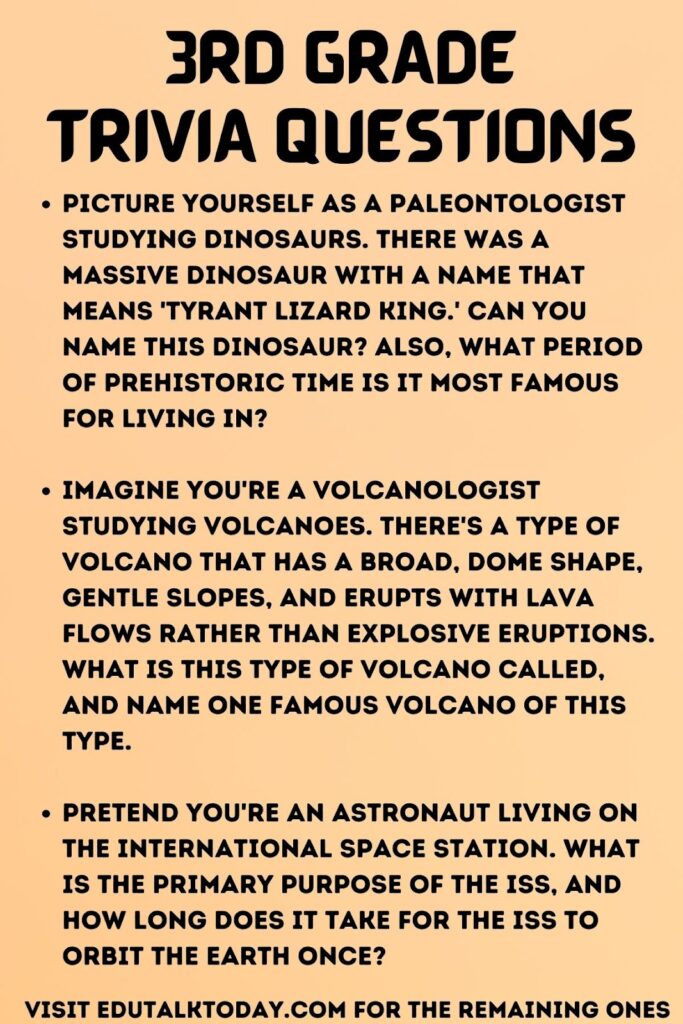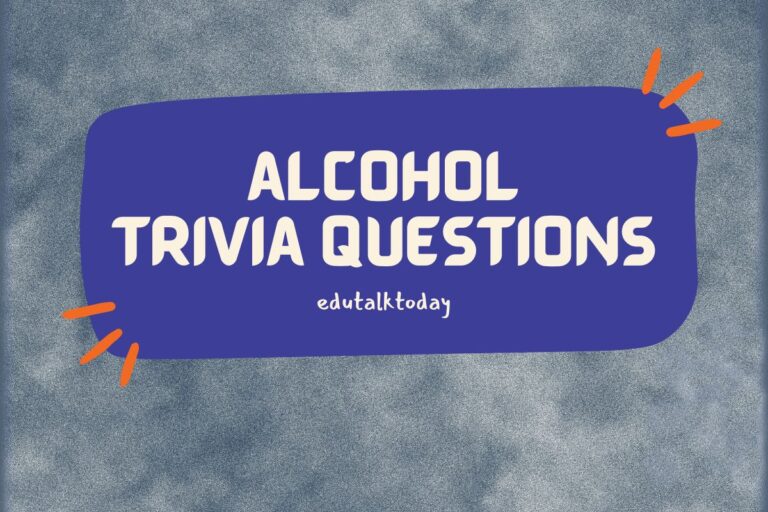36 3rd Grade Trivia Questions

Trivia questions are a fantastic way to engage young minds while promoting learning and curiosity.
For 3rd graders, trivia questions can cover a wide range of topics, from science and history to pop culture and general knowledge.
In this blog post, we’ve compiled a list of entertaining and educational trivia questions that are perfect for 3rd graders.
These questions are designed to challenge their knowledge, encourage critical thinking, and, most importantly, have fun!
So, gather your future superstars, friends, or family, and let the trivia fun begin!
3rd Grade Trivia Questions
- Astronomy Adventure: Imagine you’re an astronaut exploring outer space! Which planet in our solar system is known for its beautiful rings, is the second-largest, and would float if you could find a bathtub big enough for it? Also, name two of its many moons!
- Dinosaur Discovery: Picture yourself as a paleontologist studying dinosaurs. There was a massive dinosaur with a name that means ‘Tyrant Lizard King.’ Can you name this dinosaur? Also, what period of prehistoric time is it most famous for living in?
- Ocean Odyssey: Dive into the ocean as a marine biologist. The largest mammal on Earth lives in the ocean, can weigh up to 200 tons, and sings long, complex songs. What is this magnificent creature, and in which ocean is it most commonly found?
- Jungle Journey: As a wildlife explorer in the dense jungle, you come across a brightly colored bird known for its ability to mimic sounds, including human speech. What is this bird, and what is the term used to describe its ability to imitate sounds?
- Volcano Voyage: Imagine you’re a volcanologist studying volcanoes. There’s a type of volcano that has a broad, dome shape, gentle slopes, and erupts with lava flows rather than explosive eruptions. What is this type of volcano called, and name one famous volcano of this type.
- Ancient Architecture: Travel back in time as an archaeologist. In ancient Egypt, there are famous structures built as tombs for pharaohs. What are these structures called, and who was the pharaoh for whom the largest one was built?
- Weather Wonders: Step into the shoes of a meteorologist. When cold air meets warm air, it can create a powerful storm with strong winds, heavy rain, and sometimes hail. What is this type of storm called, and what is the term for the scale used to measure its intensity?
- Insect Inquiry: Imagine you’re an entomologist studying insects. There’s a small insect known for its ability to transform from a caterpillar into a beautiful winged creature. What is this process called, and what is the name of the insect?
- Space Station Sojourn: Pretend you’re an astronaut living on the International Space Station. What is the primary purpose of the ISS, and how long does it take for the ISS to orbit the Earth once?
- Geography Genius: As a world traveler, you come across the longest river in the world. Can you name this river, the continent it’s on, and one of the countries it flows through?
- Historical Happenings: Imagine you’re a historian studying ancient civilizations. The ancient Romans built a huge amphitheater for gladiator fights and other events. What is the name of this iconic structure, and in which city can it be found?
- Plant Puzzles: Step into the role of a botanist. There’s a unique type of plant that eats insects! What is this plant called, and how does it trap its prey?
- Math Magic: As a mathematician, you’re fascinated by shapes. There’s a shape with four equal sides and every angle is a right angle. What is this shape called, and what is the term for a three-dimensional object with six of these shapes as faces?
- Space Spectacle: As an astronomer, you witness a rare event where the Earth passes between the Sun and another planet, casting a shadow on that planet. What is this event called, and which planet is most commonly associated with this phenomenon?
- Underwater Utopia: Imagine being a marine explorer discovering the Great Barrier Reef. On which continent’s coastline can it be found, and what type of organisms primarily make up this reef?
- Musical Melody: Step into the world of music. There’s a family of instruments that produce sound by the vibration of strings. What is this family of instruments called, and name one popular string instrument from this family.
- Artistic Artifacts: As an art enthusiast, you learn about a famous painting of a woman with a mysterious smile, painted by Leonardo da Vinci. What is the name of this painting, and where is it currently housed?
- Energy Enigma: As a young scientist, you’re curious about renewable energy sources. Name a type of energy that is derived from the heat of the Earth’s interior. Also, name one country that is known for using this type of energy extensively.
- Cosmic Constellations: As a young astronomer, you study the stars. One famous constellation is known for its three bright stars in a row, representing a hunter’s belt. What is the name of this constellation, and what are the names of two stars found in it?
- Historic Leaders: Imagine you’re a historian learning about American Presidents. Who was the 16th President of the United States, famous for leading the country during the Civil War and delivering the Gettysburg Address?
- Animal Antics: As a zoologist, you study a black and white bear that loves eating bamboo and is native to China. What is the name of this bear, and what unique feature distinguishes it from other bears?
- Scientific Elements: In the world of chemistry, there’s an element with the symbol ‘O’ that we breathe every day. What is this element, and what is it called when two atoms of this element join together?
- Mighty Mountains: As an explorer, you’re climbing the highest mountain in the world. What is the name of this mountain, on which continent is it located, and what two countries does its range span?
- Literary Legends: Dive into the world of books. There’s a famous fantasy novel about a young wizard named Harry. Who is the author of this book, and what is the name of Harry’s school?
- Global Landmarks: As a world traveler, you visit a famous tower in France that was originally built for the 1889 World’s Fair. What is the name of this tower, and in which city is it located?
- Invention Insights: Imagine you’re studying famous inventors. Who is credited with inventing the light bulb, and in which country did this invention take place?
- Aquatic Adventures: As a marine biologist, you study the largest coral reef system in the world. What is the name of this reef system, and in which ocean is it located?
- Solar System Sojourn: As a young space scientist, you learn about the planets in our solar system. Which planet is known as the ‘Red Planet’ due to its reddish appearance, and what are the names of its two moons?
- Famous Explorers: Imagine you’re studying the great explorers of history. Who was the explorer credited with discovering the Americas in 1492, and which country did he sail for?
- Botanical Wonders: As a botanist, you’re fascinated by a plant that can live for thousands of years and is known for its thick trunk and long, spiky leaves. What is this plant, and where is it commonly found?
- Physics Phenomena: In the world of physics, there’s a force that pulls objects toward the center of the Earth. What is this force called, and what unit is used to measure it?
- Legendary Literature: Dive into the world of classic literature. There’s a famous play by William Shakespeare about a prince named Hamlet. In which country is this play set?
- Cultural Cuisine: As a culinary explorer, you discover a popular dish in Italy made with dough, tomato sauce, and cheese, often topped with various ingredients. What is this dish called?
- Innovative Inventions: Imagine studying the history of transportation. Who is credited with inventing the first successful airplane, and where was their first flight conducted?
- Aquatic Animals: As a marine scientist, you study a mammal known for its intelligence, playful behavior, and ability to use echolocation. What is this marine mammal?
- Historical Monuments: As a student of history, you learn about a famous wall built to protect the northern borders of a historical empire in China. What is this wall called, and when was it primarily built?
Answers
- Astronomy Adventure: Saturn is the planet with beautiful rings. It is the second-largest planet in our solar system and would float in a gigantic bathtub. Two of its many moons are Titan and Enceladus.
- Dinosaur Discovery: The ‘Tyrant Lizard King’ is the Tyrannosaurus Rex, commonly known as T-Rex. It lived during the late Cretaceous Period.
- Ocean Odyssey: The Blue Whale is the largest mammal on Earth, weighing up to 200 tons and known for its long, complex songs. It is most commonly found in the Pacific Ocean.
- Jungle Journey: The bird is a Parrot, known for its ability to mimic sounds, a skill called ‘mimicry.’
- Volcano Voyage: This type of volcano is called a Shield Volcano. One famous example is Mauna Loa in Hawaii.
- Ancient Architecture: These structures are called Pyramids. The largest pyramid was built for Pharaoh Khufu, known as the Great Pyramid of Giza.
- Weather Wonders: This type of storm is called a Thunderstorm. The scale used to measure its intensity is the Fujita Scale (or F-Scale).
- Insect Inquiry: The process is called Metamorphosis, and the insect is the Butterfly.
- Space Station Sojourn: The primary purpose of the ISS is to serve as a space environment research laboratory where scientific research is conducted in astrobiology, astronomy, meteorology, physics, and other fields. It takes about 90 minutes for the ISS to orbit the Earth once.
- Geography Genius: The Nile River is the longest river in the world. It’s located in Africa and flows through countries including Egypt and Sudan.
- Historical Happenings: The Colosseum is the ancient amphitheater in Rome, Italy.
- Plant Puzzles: The Venus Flytrap is known for eating insects. It traps its prey by closing its leaves quickly when the hairs inside are touched.
- Math Magic: The shape is a Square, and a three-dimensional object with six square faces is called a Cube.
- Space Spectacle: This event is called a Transiting. The planet most commonly associated with this is Venus.
- Underwater Utopia: The Great Barrier Reef is off the coastline of Australia. It is primarily made up of Coral.
- Musical Melody: This family of instruments is called String Instruments. One popular string instrument is the Violin.
- Artistic Artifacts: The painting is the Mona Lisa. It is housed in the Louvre Museum in Paris, France.
- Energy Enigma: Geothermal Energy is derived from the Earth’s heat. Iceland is known for its extensive use of geothermal energy.
- Cosmic Constellations: The constellation is Orion. Two stars in it are Betelgeuse and Rigel.
- Historic Leaders: Abraham Lincoln was the 16th President of the United States, known for his leadership during the Civil War and the Gettysburg Address.
- Animal Antics: The Giant Panda is the bear known for its love of bamboo and unique black and white coloring.
- Scientific Elements: The element is Oxygen. When two atoms of oxygen join together, it forms a molecule known as O2, commonly referred to as molecular oxygen.
- Mighty Mountains: Mount Everest is the highest mountain in the world. It’s located on the continent of Asia, spanning the border of Nepal and Tibet (China).
- Literary Legends: The author is J.K. Rowling, and the name of Harry’s school is Hogwarts School of Witchcraft and Wizardry.
- Global Landmarks: The Eiffel Tower is the famous tower in Paris, France.
- Invention Insights: Thomas Edison is credited with inventing the light bulb, and this invention took place in the United States.
- Aquatic Adventures: The Great Barrier Reef is the largest coral reef system in the world, located in the Coral Sea, off the coast of Australia.
- Solar System Sojourn: Mars is known as the ‘Red Planet’. Its two moons are Phobos and Deimos.
- Famous Explorers: Christopher Columbus is credited with discovering the Americas in 1492, sailing for Spain.
- Botanical Wonders: The Bristlecone Pine is known for its longevity and spiky leaves. It is commonly found in the mountains of the Western United States.
- Physics Phenomena: This force is called Gravity, and it is measured in Newtons.
- Legendary Literature: Hamlet is set in Denmark.
- Cultural Cuisine: This dish is called Pizza.
- Innovative Inventions: The Wright brothers, Orville and Wilbur Wright, are credited with inventing the first successful airplane. Their first flight was conducted in Kitty Hawk, North Carolina, USA.
- Aquatic Animals: The Dolphin is known for its intelligence, playful nature, and echolocation abilities.
- Historical Monuments: The Great Wall of China is the wall in question, primarily built during various dynasties, notably the Ming Dynasty.






